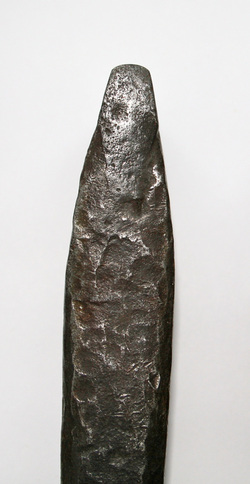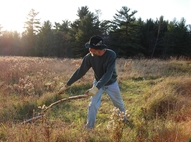 Not only did the Pennsylvania Dutch or "Deutsch", have good taste in scythe blades, they also had some world-class peening anvils, for the times, to sharpen them with. As proof that there has been a long tradition, of use of the "Austrian" scythe, in this country, these anvils are plentiful in and around Pennsylvania Dutch Pennsylvania. While all the blades seem to have been imported, these scythe anvils were hand-forged here in the USA, over a 100 years ago, out of wrought iron with a bit of hard steel inserted for the anvil face. The Pennsylvania Deutsch called them "Dengelstocks", but in their homeland Germany, the word dengelstock means the stump or base that the anvil is set in for peening, which is called "dengeln", in German. We would classify it as a tall scythe anvil. Tall anvils were usually used on large stumps that the person peening, could sit on as well. the anvil was tall enough for the seated person to get their legs underneath the blade. Most of them seem to be narrow anvils, but I have a seen some examples of wide dengelstocks in my collection. I like to point out that the Pennsylvania Dutch were actually Deutsch or German, because this is a very southern German or Bavarian-style of anvil.  Some of the anvil are beautiful examples of the craftsmanship of the blacksmiths. In this close-up photo, you can see that the anvil face is a hardened steel "bit", set into the wrought iron body of the anvil. Back in the 1800's, wrought iron was cheap and steel was expensive, so it is thought that anvils were made this way for economy's sake. That may be a major part of the reason, but I think another was that the anvil face needed to be harder than the metal of the scythe blade, hence the steel insert, but the body of anvil could be the softer wrought iron, because it would dampen the shocks of the hammer strikes, and lessen the rebound, so more energy would theoretically go into moving the metal of the edge of the blade.
4 Comments
Christiane Laganda
2/10/2014 05:23:39 am
Interesting. with wide "dengelstock" you mean a square anvil which would be "ein flacher Amboss" or a massive block with the anvil in it?
Reply
Botan Anderson
2/10/2014 06:42:42 am
Yes, it is square and top and flat, but on a tall stake. I will add a picture of it to this post.
Reply
Will
11/26/2018 06:08:10 pm
These are indeed very common in pa. I am half pa German and born in Jefferson county PA. I’ve always wondered if we invented this shape or there are identical ones in rheinpfalz where so many of us came from. If you ever see one from there I would love to know. There is also a huge collection of these with many interesting variations at the Mercer museum north of Philadelphia if you are ever there.
Reply
Dave
6/18/2020 11:17:00 am
Nice article. I just bought one that looks very similar to the ones in your photo. I had a question though about these. What is the hole used for? Thanks.
Reply
Your comment will be posted after it is approved.
Leave a Reply. |
Botan AndersonArchives
March 2023
Categories
All
|

 RSS Feed
RSS Feed